Blue bathroom tiles: pros and cons, varieties, choices, examples

When decorating a bathroom, many owners prefer a design in shades of blue. This is due to the fact that the blue color soothes, makes it possible to relax, and this is exactly what a person who takes a bath after a hard day at work needs. In addition, this color is subconsciously associated with water, and therefore it is one of the most popular when decorating a bathroom. The possibilities of using blue ceramic tiles are quite wide.
Advantages and disadvantages
There are many benefits to using blue tiles in your bathroom.
- The blue color has about 30 shades, which means that even the most discerning buyer will definitely select the most suitable color of the finishing material for his bathroom.
- In color psychology, these shades are credited with a thirst for diplomacy and conflict resolution after going to the bathroom in the morning.
- Lighter shades of blue can visually increase the space, and this is true, for example, for bathrooms in Khrushchev and other small rooms.
- According to some scientists, the blue color is frightening for bacteria, which means that the bathroom, trimmed with tiles of this tone, has an anti-cold effect, reduces the risk of disease.




Before heading to the store for blue bathroom tiles, it is important to investigate its disadvantages as well:
- some shades of blue can have a somewhat depressing effect on a person, especially on an emotionally restrained person;
- if the entire bathroom is finished exclusively in blue, then this can also negatively affect the psychological state of the household;
- ceramic tiles of this shade are offered in most hardware stores, but it can be problematic to choose plumbing to match.



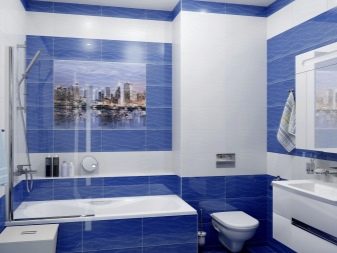
However, all these disadvantages can be eliminated. by choosing the right tiles. For example, for a bathroom, it is better not to choose large products. It is also recommended to dilute the blue squares with other tones and shades, and not to finish in a completely blue color. Plumbing that perfectly matches the color scheme with the finish can be made to order.



Varieties
You can classify ceramic tiles by texture.
- Glossy. The most demanded option. They are glossy tiles that reflect light and therefore work well in dimly lit bathrooms. Its advantage is its ease of maintenance. However, when buying glossy tiles, it is important to remember that the dark blue version will give strong reflections and can irritate the eye, so it is better to give preference to gloss in light blue tones.




- Matt. This is a calmer texture that does not reflect light. Such tiles are more often used as floor tiles, as they have a somewhat rough surface. Its advantage is the variety of textures, for example, you can find imitation of wood, pebbles, metal. The disadvantages of the matte surface include the fact that the traces of splashes on it are noticeable quite clearly.




In addition, the tile may differ in the material of manufacture. It happens:
- Glass. Suitable option for a small bathroom, visually increasing the space. The composition may contain blue dyes, which will give the tiles a bluish tint.
The production uses glass of increased strength, which has a dense non-porous structure.

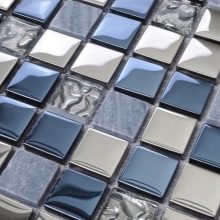
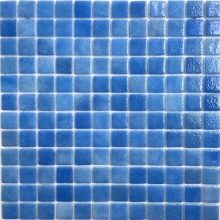
- Vinyl. A practical budget option for bathroom use. It is especially good for floor finishing, as it has anti-slip properties. And also among the advantages - ease of installation, flexibility, variety of designs.



- Three-dimensional. It is in this group that traditional ceramic tiles are included. It also includes bamboo and plastic panels. A very aesthetic option for decorating a bathroom.



How to choose?
One of the main criteria for choosing a blue bathroom tile is its size. If this is a spacious bathroom, then you can choose large products. For a small room, it is better to choose a small size, however, a very miniature mosaic tile can create the effect of an even smaller space. And also do not use blue tiles with small patterns or bright large ornaments in a small room: this design is suitable for spacious bathrooms.
The most suitable size for a small bathroom is medium. Classic options - 20X20 or 20X30 cm. If rectangular tiles are laid out horizontally, then they will visually increase the length of the room, and vertical decoration will make the ceilings taller.


Consider the type of tile as well. The most expensive, but high-quality option is grade 1 tiles. It includes a maximum of 5% waste. The most budgetary is the 3rd class, it is distinguished by the lowest quality. However, if blue tiles are bought from Russian manufacturers, then you should not look for this marking - you can study the information on the possible percentage of defects in domestic products on the packaging.
Make sure the enamel is intact, as well as its moisture resistance: water should collect on the coating in droplets. If the tile is chosen for the floor, then make sure that it does not slip.



Beautiful examples
In many cases, it is important to combine blue bathroom tiles with other colors. Consider the most interesting connection options in a different interior.
- A beautiful deep dark blue color harmonizes beautifully with light shades such as white or beige. Not suitable for a small bath, as it can further reduce the space.

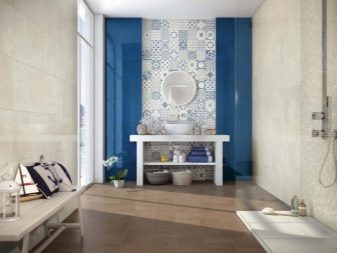
- It is customary to combine the color of the sea wave in the interior of the bathroom with other blue shades.
In psychology, it is believed that this combination calms the nervous system and relieves stress.


- When using tiles in indigo colors, avoid combining them with other saturated colors. Only monochrome colors are suitable: gray, black, white.


- If blue tiles are used in an oriental bathroom, then it must be combined with materials of a yellow, olive, black palette.

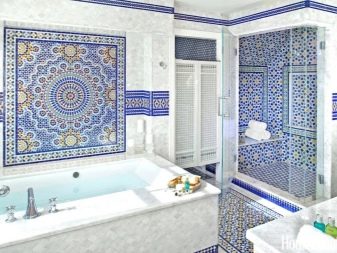
- The art deco bathroom looks luxurious, with floral designs on the tiles. And also in this direction, geometric patterns are welcome.


- The Art Nouveau style is characterized by a contrasting combination of textures. This technique, used in decoration, sets the tone for the entire interior.


You can find out how to lay tiles in the bathroom with your own hands by watching the video below.








